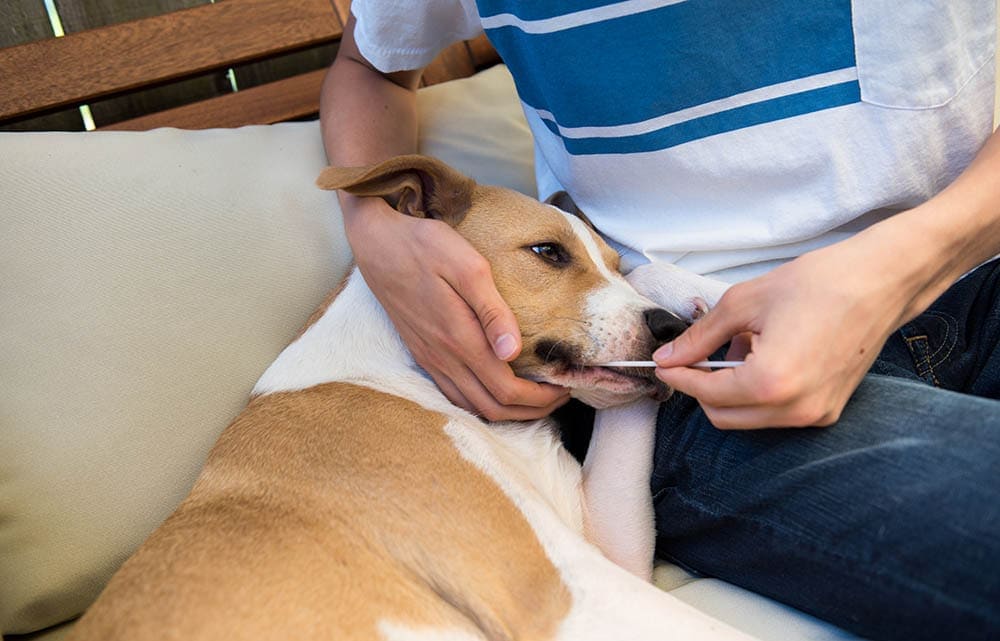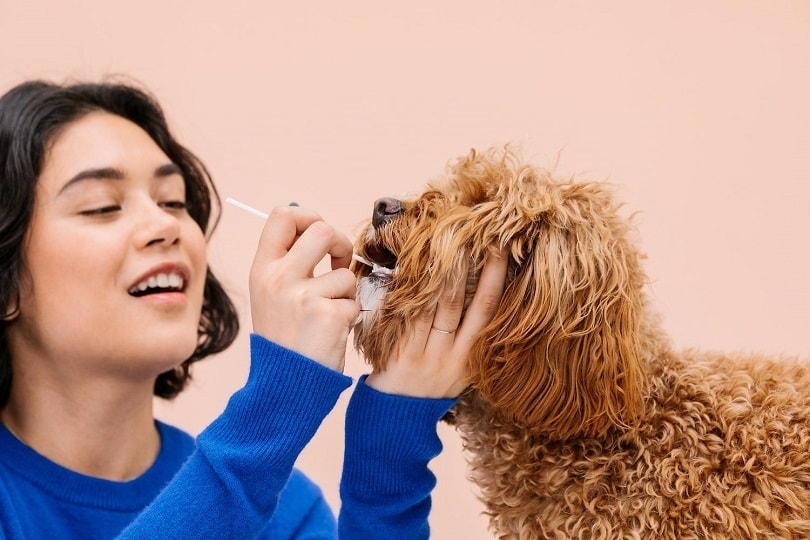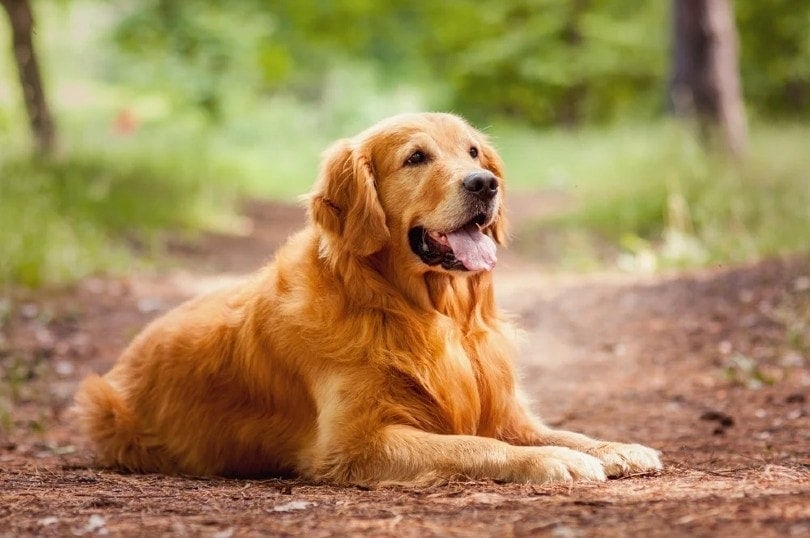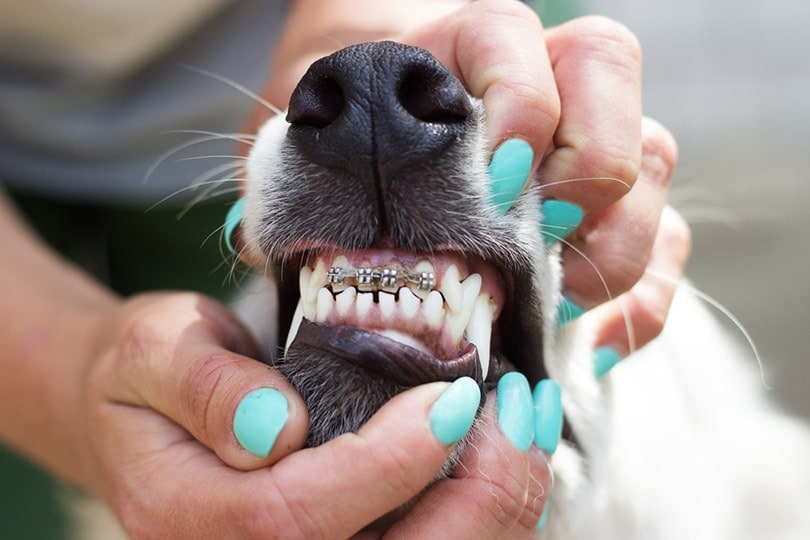Dog Color Genetics 101 (With Breeding Chart)

Updated on

Click to Skip Ahead
Between 17,000 and 24,000 years ago, humans domesticated the loyal canine. The exact date of the change from wolf to dog is debatable, but there is no doubt that dogs were the first animals to be manipulated by selective breeding. Predicting coat color in dogs is challenging due to the influences of so many factors, but scientists and breeders have a better understanding of the process thanks to discoveries such as the presence of an 8th locus that determines coat color.
Basics of Genetics
After conducting genetic experiments with pea plants, Gregor Mendel established the science of genetics. He proved that the father and mother each contribute genes to their offspring. Dogs have 78 chromosomes; 39 come from the father and 39 come from the mother. One pair of genes determines the animal’s sex, and the remaining ones affect everything else that makes the dog unique.
Chromosomes have thousands of genes with DNA-encoded traits, and each gene has allele pairs. One allele comes from the father, and one comes from the mother. Each allele has a 50% chance of being transferred to the puppies. The alleles can be dominant or recessive, and the dominant allele determines the dog’s traits.
Eumelanin (Black) and Pheomelanin (Red)
Although they do not include every color of the rainbow, the coat colors of dogs can be a wide array of hues. However, the colors are only determined by two melanin pigments. Eumelanin is the black pigment, and pheomelanin is the red pigment. How do canines display so many coat colors with two primary pigments? Each pigment has a default color that is changed by different genes. Black is eumelanin’s default pigment, but genes can modify the color to produce blue (gray), Isabella (pale brown), and liver(brown).
Pheomelanin is a red pigment with yellow or gold as the default color. Pheomelanin is responsible for reds that produce deep red, cream, orange, yellow, gold, or tan. Various genes control the influence of pheomelanin; some make it weaker, and some make it stronger. Pheomelanin only affects coat color, but eumelanin influences the nose and eye color.
The 8 Loci That Determine Coat Color
The wide range of coat colors of dogs results from pheomelanin and eumelanin being manipulated by different genes. Dogs have approximately 3 billion pairs of DNA, but only eight of the dog’s genes contribute to the coat color. Allele pairs in genes are located at sites called loci on the chromosome, and these eight loci affect the color of dogs’ fur.
A Locus (agouti)
The agouti protein affects the coat’s pattern in dogs. It’s responsible for releasing melanin into hair and switching between pheomelanin and eumelanin. The gene controls four alleles: Fawn/sable (ay), Wild sable (aw), black and tan (t), and recessive black (a).
E Locus (extension)
The extension locus creates yellow or red coats, and it’s also responsible for the black facial mask of dogs. The four alleles in the locus are melanistic mask (Em), grizzle (Eg), black (E), and red (e).
K Locus (dominant black)
The K locus determines the black, brindle, and fawn colors. It was recently discovered, but previously, scientists attributed its contributions to the A locus (agouti).
M Locus (merle)
The merle locus can create uneven shaped patches of solid color and diluted pigment. Merle dilutes the eumelanin pigment but does not affect pheomelanin. Adult dogs with yellow or red pigment are not merle but can have merle offspring.
B Locus (brown)
This locus has two brown alleles. B is dominant brown, and b is recessive brown. The brown locus is responsible for chocolate, brown, and liver colors. For black pigment to be diluted to brown, two recessive alleles (bb) must exist. The B locus can also change the color of the dog’s foot pads and nose to brown for canines in the yellow or red pigment group.
D Locus (dilute)
Due to a mutation, this site dilutes the coat color. It lightens the coat from brown or black to blue, gray, or pale brown. Dilution comprises two alleles: D is dominant full color, and d is recessive dilute. The pup must have two recessive alleles (dd) to change the black pigment to blue or gray and red pigment to cream.
H Locus (harlequin)
The H locus is responsible for white canines with black spots, and it works with the merle locus to make several combinations of colors and patches. It also influences the pheomelanin pigment, which means a sable dog with the harlequin gene can become white with black and tan patches.
S Locus (spotting)
Although a third allele in the spotting locus has not been proven, two alleles are responsible for creating white spots on any coat color. The S allele makes little or no white color, and the sp allele creates piebald (irregular patches of two colors) patterns. The S gene inhibits the cells from producing skin pigment and causes white spots to appear in the coat.
Punnett Square Examples
Before breeders were informed of the effect of the eight loci on coat color, they relied solely on the parents’ appearance to determine the coat color of the offspring. Explaining the roles of the gene sites on coat color helps you understand the complexity of guessing a dog’s color, but using Punnett squares enables you to visualize the effect of mating dogs with different genetic backgrounds. To keep the example simple, we can focus on the B locus and how it determines black or brown colors.
Mating Two Black Dogs
A breeder who mates two black adult dogs may be happy when the offspring are all black, but on another attempt with two other black dogs, they notice that one of the pups is brown. For puppies to be black, they must have BB or Bb alleles. The single brown pup must have bb genes to be brown, but what combination of alleles could produce this result? To solve this riddle, we’ll take a guess and assume both parents have a recessive gene for brown (b), but their dominant genes are black (B). That means that each parent is represented by Bb and Bb. Drawing a 3 x 3 Punnett square will show the result.
Leave the top left corner blank and put the father’s gene letters at the top and the mother’s genes going down the left column.
| B | b | |
| B | ||
| b |
After mating, the offspring will look like this:
| B | b | |
| B | BB | Bb |
| b | Bb | bb |
The bb puppy was brown because it took both of its Bb parents’ recessive alleles for brown coats. This illustrates the basics of mating heterozygous parents (Bb), but it does include the possibility of producing a yellow puppy, like a yellow or tan Pit Bull. By adding another locus into the mix, the E locus, we can demonstrate what happens when you mate a black Pit Bull with a yellow Pit Bull with a brown nose. If a pup with bb is brown and ee is yellow, you can express the color possibilities like this:
- BBEE: Black
- BBEe: Black (carries yellow)
- BBee: Yellow dog with black nose
- BbEE: Black (carries brown)
- BbEe: Black (carries brown and yellow)
- Bbee: Yellow dog with black nose (carries brown)
- bbEE: Brown
- bbEe: Brown (carries yellow)
- bbee: Yellow dog with brown nose
A black dog could be four possible combinations, but we’ll assume the black dog is BbEe. This means that the dog has a black coat but carries the brown and yellow alleles. The BbEe dog’s mate will be bbee (yellow dog with a brown nose). Creating a Punnett score for each locus and combining them is the simplest way to show the offspring.
On the B locus, we cross Bb with bb.
| B | b | |
| b | Bb | bb |
| b | Bb | bb |
Now, we mix Ee with ee.
| E | e | |
| e | Ee | ee |
| e | Ee | ee |
By taking the results of both squares, we can create a larger Punnett square placing the B locus results across the top and the E locus results down the left column.
| Bb | Bb | bb | bb | |
| Ee | BbEe | BbEe | bbEe | bbEe |
| Ee | BbEe | BbEe | bbEe | bbEe |
| ee | Bbee | Bbee | bbee | bbee |
| ee | Bbee | Bbee | bbee | bbee |
The offspring results of this mix (black Pit Bull carrying brown and yellow genes crossed with a yellow Pit Bull with a brown nose) will look like this:
- Four black dogs
- Four brown dogs
- Four yellow dogs with brown noses
- Four yellow dogs with black noses
Each puppy has a 25% chance of being black, brown, yellow with a brown nose, or yellow with a black nose. Although scientists better understand coat color genetics, a few mysteries remain. The alleles that cause a yellow coat to have shade variations have not been discovered, and researchers have not determined why some dogs’ coats gradually become lighter over time. Poodles, Bearded Collies, Old English Sheepdogs, and Bedlington Terriers carry the unidentified “gray” gene that potentially causes the coat to lighten.
DNA Testing
Punnett squares can show breeders the possible offspring combinations, but DNA testing helps determine which dogs have desirable traits. Although testing has helped breeders identify healthy dogs with fewer medical issues, the accuracy of the tests often depends on the testing facility. DNA tests sold to dog owners online are typically commercial operations, but non-profit testing companies, like those run by universities, perform detailed DNA analyses for breeders. Using a for-profit organization for testing is less expensive, but the results may not be as accurate as a non-profit tester.
Final Thoughts
Although selective breeding in dogs has been used for centuries, the process became more refined after Gregor Mendel’s experiments with genetics. Predicting the coat colors of dogs is still tricky due to the unidentified loci that can dilute melanin pigments, but breeders have a higher probability of success because of new research into canine genetics and the use of DNA testing.
Featured Image Credit: Anna Hoychuk, Shutterstock













